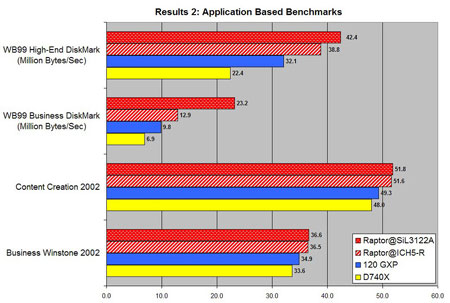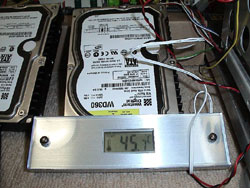|
|
|
|
|
Western Digital Raptor 10k-RPM HDD |
|
Join the community - in the OCAU Forums!
|
Application-based Benchmarks, Usage, Final Words
We then tested the Raptor with benchmarking programs based on applications that are usual for a desktop environment. We did not test the Raptor for server purposes. Unfortunately there is only the rather dated Winbench 99 test program currently available for application based HDD benchmarking. WB99 is running a collection of high-end desktop applications. They are I/O bound and scripted in such a way that they are intensively reading and writing from and to the disk. WB99 comprises among others 2 benchmarking test sets, one representing a business environment and the other one a high-end desktop environment. In addition we ran Content Creation 2002 and Business Winstone 2002. They as well are simulating PC usage with business and content creating applications such a Lotus Notes, various MS Office applications, FrontPage, Photoshop, Sound Forge and others.
 

click to enlarge
In Winbench 99 the Raptor is leaving the 7,200 disks far behind in both the High-end DiskMark and the Business DiskMark. We knew from previous tests already that the Maxtor D740X is not doing well in Winbench 99. But even the 120 GXP, a solid performer, is 30% slower than the Raptor in High-end DiskMark and 60% slower in the Business DiskMark. Interesting is that the Raptor seems to run the Winbench 99 tests substantially faster from the SiL3122A controller than from the ICH5.
In Content Creation and Business Winstone the Raptor is again ahead of the 2 tested 7,200 disks, but this time with much smaller margins. The difference is around 8% between the D740X and the Raptor, and the 120GXP falling in between. The Raptor is again running faster from the Sil3122A controller than from the ICH5, but only very slightly. The performance difference between the Raptor and the 7,200 rpm disks seems to be rather small in comparison with Winbench 99. Content Creation 2002 and Business Winstone 2002 are testing overall system performance. They are not as I/O bound as Winbench 99 and do therefore not isolate HDD performance as much as Winbench 99, which intentionally magnifies HDD performance differences. That is legitimate for testing purposes. On the other hand the differences shown in Content Creation and Business Winstone are probably better representing real world results than Winbench 99. In this respect a performance gain between 5% and 8% is quite substantial.
GENERAL USAGE
A 10,000 rpm rotational speed is naturally producing more heat and vibration than 7,200 rpm. As already mentioned the Raptor has a more sturdy housing than a usual 7,200 rpm HDD and a heatsink-like rugged design on one side of the disk case to compensate for this. We measured a temperature of 34C in idle and around 45C under load on the hottest spot of the housing with the disk NOT installed in the case. When the disk is connected to a PC case the disk temperature should slightly decrease due to the heat transfer from the disk housing into the case material. However, a lack of airflow inside a case could produce a heat problem. The Raptorís temperatures were slightly higher than with the 120 GXP but at the same level as the D740X. Nonetheless we would recommend to use active cooling when 2 Raptor are coupled for a RAID array and not to place them very close together.

We were surprised about the Raptorís low noise level. We expected the 10,000 rpm motor to generate some weird high-pitched sound, but heard nothing like this. The Raptor sounds a little different from 7,200 disks, but it is not unpleasant or more noisy. The Raptorís mechanical clicks and clacks when the heads are moving is definitely less than with the D740X and at the same noise level as the 120GXP. The Raptor can be classified as a rather silent disk. Another pleasant experience is loading Windows XP with the Raptor. The much improved disk access time provided by the 10,000 speed comes into play here. The Raptor is loading Windows noticeably faster than the 7,200 disks in our test. Our feeling was that running the Raptor from the SiL3122A port provided the fastest loading.
FINAL WORDS
The results speak loud and clearly for themselves. The Western Digital 10,000 rpm Raptor is a stellar performer leaving the 7,200 rpm competition far behind. This Western Digital harddisk drive is a must for the enthusiast desktop user. A street price of around 160 US$ is expensive considering the capacity of only 36 GB, but the price premium is certainly not frivolous considering the performance gain you get with the Raptor and its 5 year warranty period. The other 2 disks in our test come only with a 1-year warranty. We applaud Western Digital for being the first manufacturer with a 10,000 rpm IDE disk in the market. It has to be noted that this is Western Digitalís second important innovation in a short period of time after their 8 MB cache JB series. Stay tuned for part 2 of our Raptor test when we run 2 and 4 Raptors in RAID 0.
Update: Part 2 is now available here!
|
|
Advertisement:
All original content copyright James Rolfe.
All rights reserved. No reproduction allowed without written permission.
Interested in advertising on OCAU? Contact us for info.
|

|


